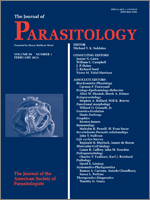Parasite distributions fundamentally depend on the distributions of their hosts but may be more restricted than their hosts. Host–parasite symbioses tend to be spatially aggregated, and widely distributed host–parasite relationships are rare. Here, we combine field observations with published collection data to document the current known distribution of the nematode, Myrmeconema neotropicum, which infects the Neotropical canopy ant Cephalotes atratus. We report 6 new records from different Brazilian ecosystems, bringing the total number of independent observations of this interaction to 11. The broad distribution of these data points suggests that M. neotropicum infects C. atratus throughout its geographic range, although possible disturbance effects and specific habitat associations of the interaction remain unknown.
How to translate text using browser tools
1 February 2013
The Geographic Distribution of Parasite-Induced Fruit Mimicry in Cephalotes atratus (Formicidae: Myrmicinae)
Wesley Dáttilo,
Jéssica C. F. Falcão,
Stephen P. Yanoviak,
George Poinar Jr.,
Thiago J. Izzo
ACCESS THE FULL ARTICLE

Journal of Parasitology
Vol. 99 • No. 1
February 2013
Vol. 99 • No. 1
February 2013




